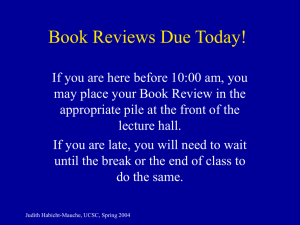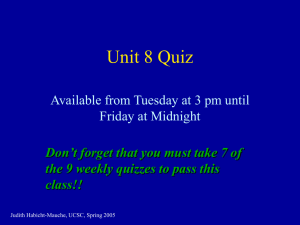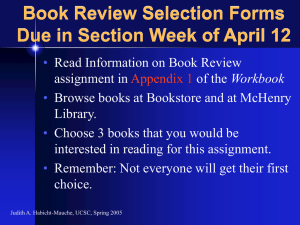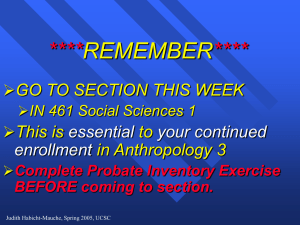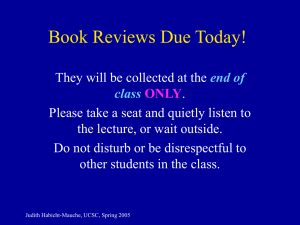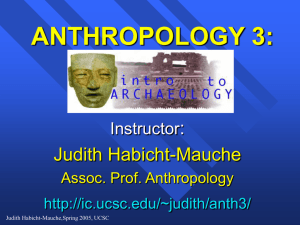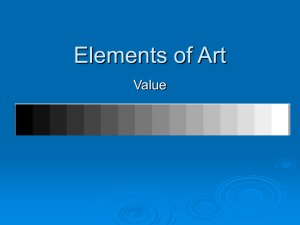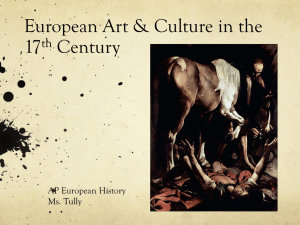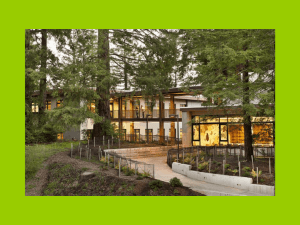Middle Range Research
advertisement
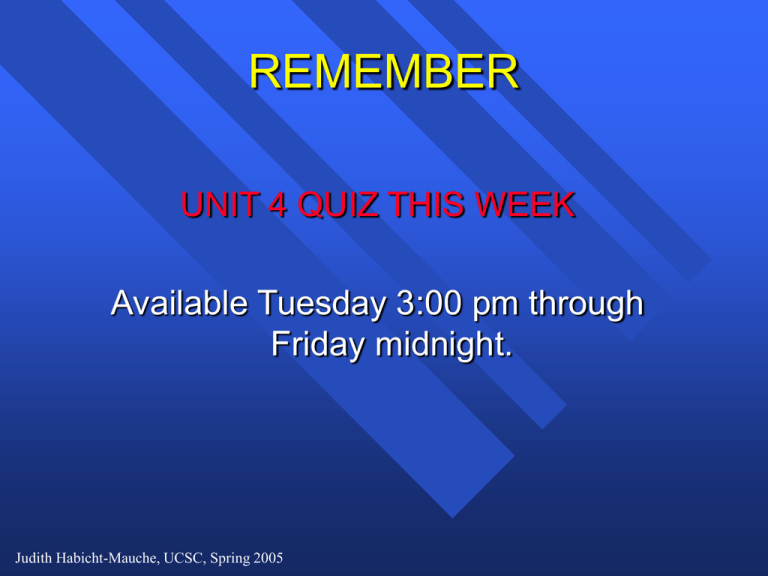
REMEMBER UNIT 4 QUIZ THIS WEEK Available Tuesday 3:00 pm through Friday midnight. Judith Habicht-Mauche, UCSC, Spring 2005 Gravestone Seriation Reports Due is Sections this Week. Judith Habicht-Mauche, UCSC, Spring 2005 Check Book Review Assignment Lists in Section Room You MUST read the book that you have been assigned Also pick up set of reading and writing prompts in Section Room Judith Habicht-Mauche, UCSC, Spring 2005 Excavation “Archaeologists murder their informants when they question them”~K. Flannery Control location of artifacts and features in three dimensions (x,y,z coordinates) Grid System--controls x, y coordinates Datum--fixed elevation Old Technology: tape measure, plum bob, pencil and graph paper New Technology: GPS, TMS, etc. Judith Habicht-Mauche, UCSC, Spring 2005 Excavation Strategies (1) Early Coalition Period Vertical Pits or Trenches Diachronic: examines changes through time Late Coalition Period Judith Habicht-Mauche, UCSC, Spring 2005 Example: Pajarito Project, NM (1982) Three single component sites from different temporal periods Vertical test pits (“telephone booths”) in middens Flotation samples taken from each arbitrary 10 cm level Excavation Strategies (2) Open Area/Horizontal Excavations Synchronic: snapshot of activities and associations at one point in time Example: Duncan Site, OK (1984) Single component, short term, seasonal occupation Remove plow zone to reveal features (pits, posts, hearths) Judith Habicht-Mauche, UCSC, Spring 2005 Unit 4 RECOVERING & INTERPRETING EVIDENCE Lecture 2: Site Formation Processes and Middle Range Research Judith Habicht-Mauche, UCSC, Spring 2005 Lewis Binford (1983) “The archaeological record is contemporary; it exists with me today and any observation I make about it is a contemporary observation.” Judith Habicht-Mauche, UCSC, Spring 2005 How can we make inferences about the past based on observations in the present? Archaeological Context: Static material record in the present Systemic Context: Dynamic human actions in the past Need to establish bridging arguments (if-then statements) that link the dynamic actions of the past to their material correlates in the present. Judith Habicht-Mauche, UCSC, Spring 2005 Site Formation Processes (Michael Schiffer) Study of how the archaeological record is formed how things move, and are transformed as they move, from systemic contexts into archaeological contexts. Judith Habicht-Mauche, UCSC, Spring 2005 Cultural Processes Deposition Reclamation Example: Stone Lion Shrine, New Mexico Reuse Disturbance Judith Habicht-Mauche, UCSC, Spring 2005 Non-Cultural Processes Differential Preservation Catastrophic Events Examples: Pompeii, Cerén Natural Disturbance Patterns we recover archaeologically are not always a direct reflection of past human behavior. Judith Habicht-Mauche, UCSC, Spring 2005 Middle Range Research Body of theory and practice that attempts to bridge the gap between the dynamics of past human behavior and its material consequences in the present. Judith Habicht-Mauche, UCSC, Spring 2005 Middle Range Research is… Actualistic from Latin root actuo = present based on Observation, Experiment, Analogy informed by Uniformitarian assumptions Same methods used by other sciences, like astronomy, geology, forensics Judith Habicht-Mauche, UCSC, Spring 2005 Analogy & Uniformitarianism in Middle Range Research experiment, ethnoarchaeology, etc. The present The past Judith Habicht-Mauche, UCSC, Spring 2005 Controlled comparison Middle Range Research and Truth Archaeological stories are not “true” or “false”; not “right” or “wrong”. But only “more or less convincing” (robust) based on the strength of the observations, experiments, and analogies used to construct them. Judith Habicht-Mauche, UCSC, Spring 2005 Building Analogy through Middle Range Research (1) Ethnographic and Historic Analogy Direct Ethnographic Analogy (“living fossils”) Direct Historical Approach Example: A.V. Kidder at Pecos Judith Habicht-Mauche, UCSC, Spring 2005 Building Analogy through Middle Range Research (2) Ethnoarchaeology/Living Archaeology Ethnography done by archaeologists, directed toward answering very specific middle range questions. Example: Lewis Binford among the Nunamiut caribou hunters of Alaska Judith Habicht-Mauche, UCSC, Spring 2005 Building Analogy through Middle Range Research (3) Experimental Archaeology Example: Lawrence Keeley (1977)--stone tool replication and edge-wear analysis Confirmed and contradicted some common assumptions about prehistoric stone tool use based on formal attributes. Judith Habicht-Mauche, UCSC, Spring 2005 Studies of Site Formation Processes and Middle Range Research One of the most important and lasting contributions of “Processual Archaeology” (1960s-1980s). Made archaeologists more aware of the sources of potential bias in our analogic arguments. Made archaeological interpretations stronger and more convincing. Judith Habicht-Mauche, UCSC, Spring 2005
